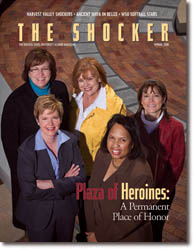
Thanks, Anita Skeen
Dear The Shocker:
Thank you for the mention of our involvement in the formation of the women’s studies community council (“Brick by Brick,” spring 2008). This came about after the four of us took a journal writing class taught by Anita Skeen.
The semester turned out to be life-changing for all of us. We saw the transformative effect that intellectual challenge and self-exploration could provide for women. We realized the impact that could be made by recognizing the oft-unreported contributions women have made throughout history.
We are pleased that the community council has grown and is important to the university.
We want it to be known that Anita Skeen was our inspiration. Although she now teaches at Michigan State University, she left an indelible mark on the students she inspired during her years at WSU.
Sincerely,
Allison Price ’80, London, England
Vicki Stamp Luke ’88, Wichita
Linda Talbott fs ’89, Kansas City, Mo.
Nancy Riley Smith ’91, Austin, Texas
Digging Uxbenká
Dear The Shocker:
The article (“In the Shadows,” spring 2008) turned out great. Thank you for giving me the opportunity to share about my research, and thanks for making it sound so interesting!
Amber Schrag, Wichita
Dear The Shocker:
Thanks for (the article “In the Shadows”). Amber is correct in pointing out that there is a relative dearth of information about the daily lives of ancient non-elite Maya. For a long time in the discipline, most archaeologists tended to gravitate towards the large temples and palace structures which, while important in helping us to understand the political and religious structures of ancient Maya society, only reflect a very small sector of the whole society.
During the 1970s and 1980s some archaeologists pointed out this disparity and founded what is often called “household archaeology,” which focuses on the domestic lives of ancient peoples. With this change in focus came the realization that a wealth of information about ancient societies had long been overlooked, from seemingly mundane things such as diet and subsistence patterns to the intricacies of household rituals, religious practices and treatment of dead ancestors.
Amber’s work falls within this context, as she is focusing on a residential group associated with the Classic Maya site of Uxbenká. While our primary goal with the project is to better understand the chronology and development of sociopolitical complexity in southern Belize, Amber’s work is helping us understand the implications of these political changes on the local populations and their role in the emergence of a centralized political system.
Best regards,
Andrew Kindon, Ph.D., West Valley College, anthropology department chair and co-principal investigator of the Uxbenká Archaeological Project





